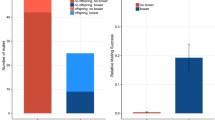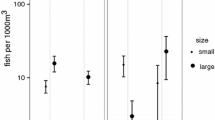Abstract
In many species of East African cichlids, males build sand craters or “bowers” to attract females for spawning. It is commonly assumed that these exaggerated sexual traits have a function similar to bodily ornaments. In non-bodily ornaments, however, the behaviour creating the structure may serve as an additional source of information to potential partners, providing multiple signals for mate choice. We tested whether and to what extent females use these signals for choosing males by observing the individual sampling behaviour of female Cyathopharynx furcifer in the field. In addition, we experimentally manipulated crater characteristics in the field and laboratory. We found that females spawn preferably with owners of large and well-maintained craters, but when crater size was enlarged or reduced, the resulting building activity of crater owners affected female choice more strongly than the manipulated crater size per se. We discuss the importance of multiple signals in species constructing extended phenotypes.






Similar content being viewed by others
References
Borgia G (1995) Complex male display and female choice in the spotted bowerbird—specialized functions for different bower decorations. Anim Behav 49:1291–1301
Borgia G, Presgraves DC (1998) Coevolution of elaborated male display traits in the spotted bowerbird: an experimental test of the threat reduction hypothesis. Anim Behav 56:1121–1128
Candolin U (2003) The use of multiple cues in mate choice. Biol Rev 78:575–595
Candolin U (2004) Why do multiple traits determine mating success? Differential use in female choice and male competition in a water boatman. Proc R Soc Lond B Biol Sci 272:47–52
Christy JH, Backwell PRY, Goshima S, Kreuter T (2002) Sexual selection for structure building by courting male fiddler crabs: an experimental study of behavioral mechanisms. Behav Ecol 13:366–374
Christy JH, Backwell PRY, Schober U (2003a) Interspecific attractiveness of structures built by courting fiddler crabs: experimental evidence of a sensory trap. Behav Ecol Sociobiol 53:84–91
Christy JH, Baum JK, Backwell PRY (2003b) Attractiveness of sand hoods built by courting male fiddler crabs, Uca musica: a test of a sensory trap hypothesis. Anim Behav 66:89–94
Coleman SW, Patricelli GL, Borgia G (2004) Variable female preferences drive complex male displays. Nature 428:742–745
Doucet SM, Montgomerie R (2003) Bower location and orientation in Satin Bowerbirds: optimising the conspicuousness of male display? Emu 103:105–109
Dunn PO, Whittingham LA, Freeman-Gallant CR, DeCoste J (2008) Geographic variation in the function of ornaments in the common yellowthroat Geothlypis trichas. J Avian Biol 39:66–72
Endler JA, Houde AE (1995) Geographic variation in female preferences for male traits in Poecilia reticulata. Evolution 49:456–468
Espmark, Y, Amundsen T, Rosenqvist G (eds) (2000) Animal signals: signaling and signal design in animal communication. Tapir Academic, Trondheim
Fawcett TW, Johnstone RA (2003) Optimal assessment of multiple cues. Proc R Soc Lond B Biol Sci 270:1637–1643
Gabor CR, Ryan MJ (2001) Geographical variation in reproductive character displacement in mate choice by male sailfin mollies. Proc R Soc Lond B Biol Sci 268:1063–1070
Genner MJ, Young KA, Haesler MP, Joyce DA (2008) Indirect mate choice, direct mate choice and species recognition in a bower-building cichlid fish lek. J Evol Biol 21:1387–1396
Gladwell M (2007) Blink: the power of thinking without thinking. First paperback edition. Little, Brown and Company, Time Warner Book Group, New York
Hebets EA, Papaj DR (2005) Complex signal function: develo** a framework of testable hypotheses. Behav Ecol Sociobiol 57:197–214
Immler S, Taborsky M (2009) Sequential polyandry affords post-mating sexual selection in the mouths of cichlid females. Behav Ecol Sociobiol 63:1219–1230
Johnstone RA (1995) Honest advertisement of multiple qualities using multiple signals. J Theor Biol 177:87–94
Karino K (1997) Female mate preference for males having long and symmetric fins in the bower-holding cichlid Cyathopharynx furcifer. Ethology 103:883–892
Kellog KA, Stauffer JR, McKaye KR (2000) Characteristics that influence male reproductive success on a lek of Lethrinops c.f. parvidens (Teleostei: Cichlidae). Behav Ecol Sociobiol 47:164–170
Künzler R, Bakker TCM (2001) Female preferences for single and combined traits in computer animated stickleback males. Behav Ecol 12:681–685
Maan ME, Seehausen O, van Alphen JJM (2010) Female mating preferences and male coloration covary with water transparency in a Lake Victoria cichlid fish. Biol J Linn Soc 99:398–406
Madden JR (2002) Bower decorations attract females but provoke other male spotted bowerbirds: bower owners resolve this trade-off. Proc R Soc Lond B Biol Sci 269:1347–1351
Madden JR (2006) Interpopulation differences exhibited by Spotted Bowerbirds Chlamydera maculata across a suite of male traits and female preferences. Ibis 148:425–435
Martin CH, Genner MJ (2009) A role for male bower size as an intrasexual signal in a Lake Malawi cichlid fish. Behaviour 146:963–978
McKaye KR, Louda SM, Stauffer JR (1990) Bower size and male reproductive success in a cichlid fish lek. Am Nat 135:597–613
Milinski M, Bakker TCM (1990) Female sticklebacks use male coloration in mate choice and hence avoid parasitized males. Nature 344:330–333
Östlund-Nilsson S, Holmlund M (2003) The artistic three-spined stickleback (Gasterosteous aculeatus). Behav Ecol Sociobiol 53:214–220
Rossiter A (1997) Intraspecific plasticity in the social system and mating behaviour of a lek-breeding cichlid fish. In: Kawanabe H, Hori M, Nagoshi M (eds) Fish communities in Lake Tanganyika. Kyoto University Press, Kyoto, pp 194–217
Schaedelin FC, Taborsky M (2006) Mating craters of Cyathopharynx furcifer (Cichlidae) are individually specific, extended phenotypes. Anim Behav 72:753–761
Schaedelin FC, Taborsky M (2009) Extended phenotypes as signal. Biol Rev 84:293–313
Scheuber H, Jacot A, Brinkhof MWG (2003) The effect of past condition on a multicomponent sexual signal. Proc R Soc Lond B Biol Sci 270:1779–1784
Soler M, Soler JJ, Møller AP, Moreno J, Linden M (1996) The functional significance of sexual display: stone carrying in the black wheatear. Anim Behav 51:247–254
Acknowledgements
We thank Valerio Rizzo, Dr. Katharina Peer and Dr. Oliver Otti for field assistance and helpful comments. We thank Dr. H. Phiri, R. Shapola, L. Makasa, D. Sinyinza and C. Lukwesa from the Fisheries Department, Mpulungu, Zambia, for their continuous support of our project. The experiment described in this manuscript complies with the current laws of Zambia, the country in which the study was conducted. We thank the Ministry of Agriculture and Co-operatives of Zambia, in particular Director C. Kapasa, for permission and support. We thank the members of the Lake Tanganyika diving expeditions 2002 and 2003 for their assistance and R. Eggler, S. Maurer and P. Stettler for help in organisation. The project was supported by the Swiss National Science Foundation (SNSF grants 3100-064396 and 3100A0-105626 to M.T.). The breeding program and the experiments were approved by the Veterinary Authority of the Kanton Bern, Switzerland, and conducted under the licenses No 27/01, 30/01 and 30/02.
Author information
Authors and Affiliations
Corresponding author
Additional information
Communicated by C. Gabor
Rights and permissions
About this article
Cite this article
Schaedelin, F.C., Taborsky, M. Female choice of a non-bodily ornament: an experimental study of cichlid sand craters in Cyathopharynx furcifer . Behav Ecol Sociobiol 64, 1437–1447 (2010). https://doi.org/10.1007/s00265-010-0959-3
Received:
Revised:
Accepted:
Published:
Issue Date:
DOI: https://doi.org/10.1007/s00265-010-0959-3




